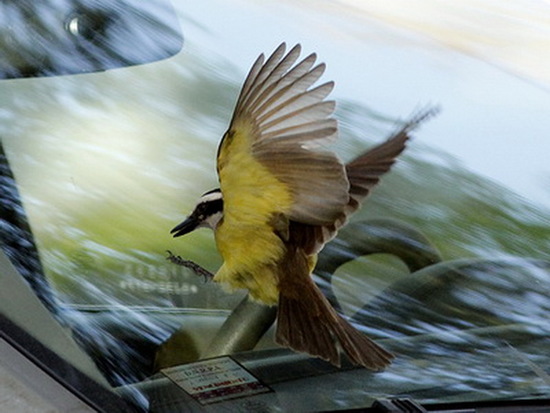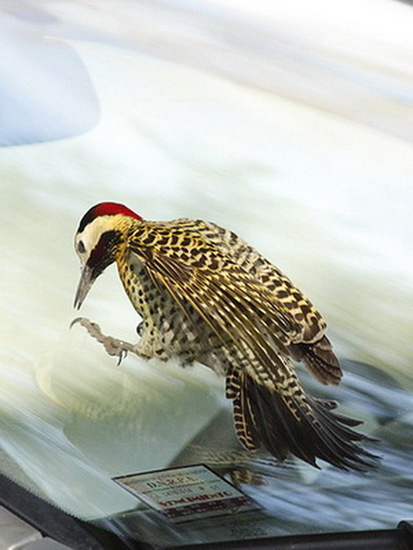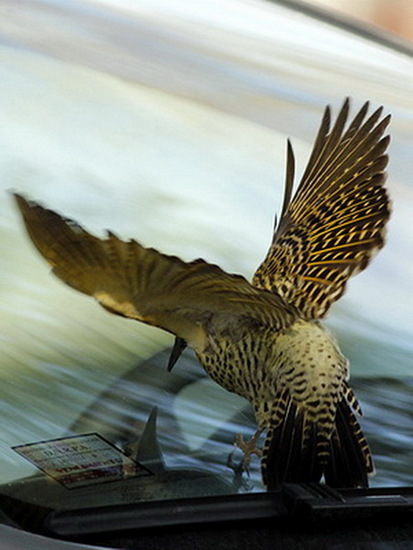The green-barred woodpecker and the windscreen
The photos and the video were taken at the Viamonte Access. The green-barred woodpecker spontaneously started to play by itself on the windscreen. It spent quite a while. Then a great kiskadee and another green-barred woodpecker appeared
Playing with the meaning of having fun is a concept difficult to prove when it is applied to birds.Their behaviours tend to be associated with the satisfaction of basic needs. A non explicitly agressive chase is associated with a territorial fight.
Away from the routine of their natural world behaviours may be analyzed from a different point of view. This scene takes place outside the reserve where common (trees) or foreign, though not strange, elements such as food stands, cars, etc. form part of the landscape. Birds are not pressed to interact with them and we can observe that not all bird species seem interested in them. The green-barred woodpecker shows this curiosity. For some reason the windscreen calls its attention. Accidentaly the woodpecker slides down the windscreen, experiences a pleasant effect which produces a mechanical action and repeats the action many times.
But we are not in front of a fortuitous event. People working there say that a woodpecker is frequently seen playing on windscreens. If it is the same individual it has incorporated some learning. If not, is this behaviour imitated by others?
Away from the routine of their natural world behaviours may be analyzed from a different point of view. This scene takes place outside the reserve where common (trees) or foreign, though not strange, elements such as food stands, cars, etc. form part of the landscape. Birds are not pressed to interact with them and we can observe that not all bird species seem interested in them. The green-barred woodpecker shows this curiosity. For some reason the windscreen calls its attention. Accidentaly the woodpecker slides down the windscreen, experiences a pleasant effect which produces a mechanical action and repeats the action many times.
But we are not in front of a fortuitous event. People working there say that a woodpecker is frequently seen playing on windscreens. If it is the same individual it has incorporated some learning. If not, is this behaviour imitated by others?
27-11-11 © Roberto Ares
Sliding down a windscreen
The action takes place for more than half an hour
The attitude of certain birds when looking at mirrors is explained differently. Many believe birdss see a competitor. Here the woodpecker is not looking itself at the mirror and there is no agressive attitude towards its own image on the windowscreen. Does it recognize itself or is it so immersed in sliding that it pays no attention to it? Some bird species are known to recognize themselves in the mirror but this ability can not be applied to rest of all species. Neither can we say that within the same species all individuals behave alike. Not all woodpeckers exhibit this ludic behaviour.
While the other woodpecker was there it did not show any interest in the action. Instead, the great kiskadee's attitude is striking. It joins the woodpecker and tries to imitate it. It is not successful since it climbs instead of letting itself fall. Perhaps too much effort and no reward made it give up the scene.
A scene with too many readings. If this scene shows that the woodpecker is having fun it is possible that they have fun much more than we may imagine.
While the other woodpecker was there it did not show any interest in the action. Instead, the great kiskadee's attitude is striking. It joins the woodpecker and tries to imitate it. It is not successful since it climbs instead of letting itself fall. Perhaps too much effort and no reward made it give up the scene.
A scene with too many readings. If this scene shows that the woodpecker is having fun it is possible that they have fun much more than we may imagine.







